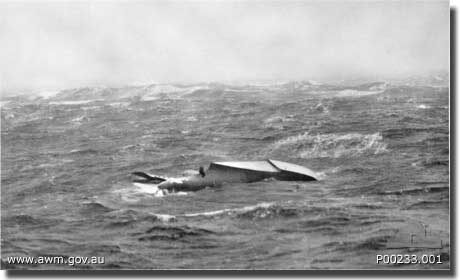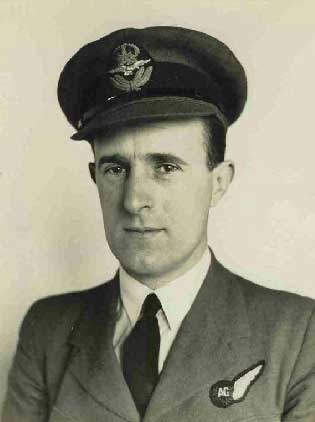|
HMAS Australia to the rescue
At that time, we had arrived on the Clyde at Greenock, Scotland, only two days earlier, after passage from Gibraltar. What a contrast we found the weather from our recent time in the tropics, cold bleak days and even colder nights, and rough Atlantic Ocean weather to cope with at sea. We were ordered to sea that afternoon, to join a search for a German Merchant Raider, reported to be operating against our shipping, that was keeping open the life line from the United States and Canada. The convoys were a necessity for Britain's survival, bringing food, oil, etc. to allow the continued struggle against Germany by Britain and her Dominions, Australia, Canada, and New Zealand. In 1940, this small group alone represented the free world against the might of the Third Reich. The Australia and her crew were here to play our own small part in those very dark days. Notwithstanding the growing U-Boat menace, and the wide geographic area covered by long range German aircraft, our Merchant ships were still at sea, sailing the world's oceans, and many survived to arrive at their destinations on the west coast of the United Kingdom. As Tuesday dawned, we learned about a Coastal Command Sunderland Flying Boat, that had to make a forced landing in the Atlantic Ocean west of the Hebrides. Our task was to try and locate this stricken Royal Air Force plane, and save her crew. There was a gale blowing in earnest, the barometer had fallen, and was still going down, visibility was poor, and finding this Sunderland in such adverse conditions appeared difficult, if not unlikely. The ship was running with an extremely rough sea, rolling heavily from port to starboard, and then all over again. Just after noon we received a message from the flying boat: Hurry up.... am breaking up.
The Sunderland down in the Atlantic that HMAS Australia was able to rescue 9 airmen from, During the afternoon watch, the flying boat kept up transmitting on her radio, so that we could use our directional finding equipment to locate her, and then run down this D/F bearing. The weather was awful, and as we approached closer to her estimated position we made smoke at intervals, hoping her crew might spot us. Visibility was now very low, and we had increased speed to 26 knots in an attempt to arrive before it was too late, but the ship was making very heavy weather of the prevailing conditions. By now, a huge sea was running, and our heavy cruiser, when picked up on the crest of each wave, was literally surfing down into the next trough, with the wind now blowing at gale force. When surfing, the ship picked up several extra knots over her speed of 26 knots, and we actually touched 30 knots on the speed indicator. At 1435 (2.35 PM) the Sunderland hove into view right ahead, her tail only ocassionally visible above the huge waves, a crew member constantly operating a flashing light to guide us. When but a half a mile from the flying boat, one of the floats dropped off, a moment later, an enormous wave picked up the Sunderland and flipped it completely over on it's back. We could only see one crew member perched on the upturned boat. We now approached from upwind, allowing the gale force winds to drift us down onto the site of the wreckage, ropes had been prepared over our starboard side, scrambling nets, and jumping ladders were also in place over the starboard side. We suddenly sighted a group of airmen in the water with life jackets on, the ship drifted down to them and ropes were passed. However, the rough and icy Atlantic was not going to give up this group easily, the conditions prevented the airmen from securing a rope around themselves, they were just too exhausted to tie a knot, salvation at hand, but were the elements going to win this struggle after all? Australia was rolling heavily, one minute the Starboard side would be feet under water, then a heavy roll would reverse to port, and the starboard side would be well clear of the water. Given the wind force, and the state of the sea, the only way to pluck our survivors from the clutches of the Atlantic was to send several Officers and Sailors over the side with bowlines to secure to each airman. These volunteers were led and encouraged by the ship's executive Officer, Commander J.M. (Jamie or Black Jack) Armstrong. RAN. One by one the airmen had to be hauled on board, with the ship rolling heavily, the airmen's water logged gear making each rescue a long and difficult task. Persistence and sheer bravery from those over the side securing each airman finally triumphed. Nine of the crew of thirteen were finally on board, suffering from exposure, and seasickness, but they were now safe, and would all be fine after time spent in our sick bay. The remaining four airmen drifted out of reach, just clear of Australia's bow, and could not be reached. I was up in the bows with a team of seamen, trying to reach this group with heaving lines, but the force of the wind made this task impossible to cast a line, it merely blew back into one's face before achieving its objective, to reach the doomed four. It was total frustration, rescue but several yards away, and we could not reach the group, no boat could have survived in these seas. At 1725 (5.25 PM) after many hours taken up in this rescue operation, we were forced to abandon our task, we altered course to the South, and proceeded at only 9 knots into the face of this storm. The Sunderland had left base at 1700 (5 PM) on Monday evening, despatched to escort a convoy. The poor visibility prevented them from finding their convoy, and the weather became too bad to enable the crew to obtain a D/F bearing of their base, the high winds caused more petrol to be used than normal, and at 0700 (7 AM) the next morning they just ran out of petrol, and were forced to attempt a landing in the Atlantic Ocean. It was a magnificant feat of airmanship for the pilot to put down his flying boat into this raging sea without capsizing it. The Sunderland had survived seven and a half hours in a howling Atlantic gale before their luck ran out, and the boat was overturned. The airmen were all seasick and very weak from their ordeal. Although this rescue took place almost sixty two years ago, I can still visualise the joy on the faces of those we rescued, and remember the anger and sadness we all experienced at having to leave the remaining four airmen to face a certain death. War is HELL! See the article about our search for the survivors' identities. The names from Australia's Log: No initials were recorded.
The rescue was made at 1437, and the search for the last 4 was abandoned at 1725,when visibility was down to about 500 yards. At noon the ship's position by Dead Reckoning was 60 degree 20 minutes North, 10 degrees 12 minutes West. When we abandoned the search, the wind strength on the Beaufort Scale was Force 10, ie seas up to 30 feet high with wind up to 55 mph. With the sea behind us, when steaming to the Sunderland, we made 26 knots, I can recall watching us surf a wave and the speed going up to about 31 knots, after the rescue we steamed into the sea and made but 9 knots. The exciting search for the names now over. |



